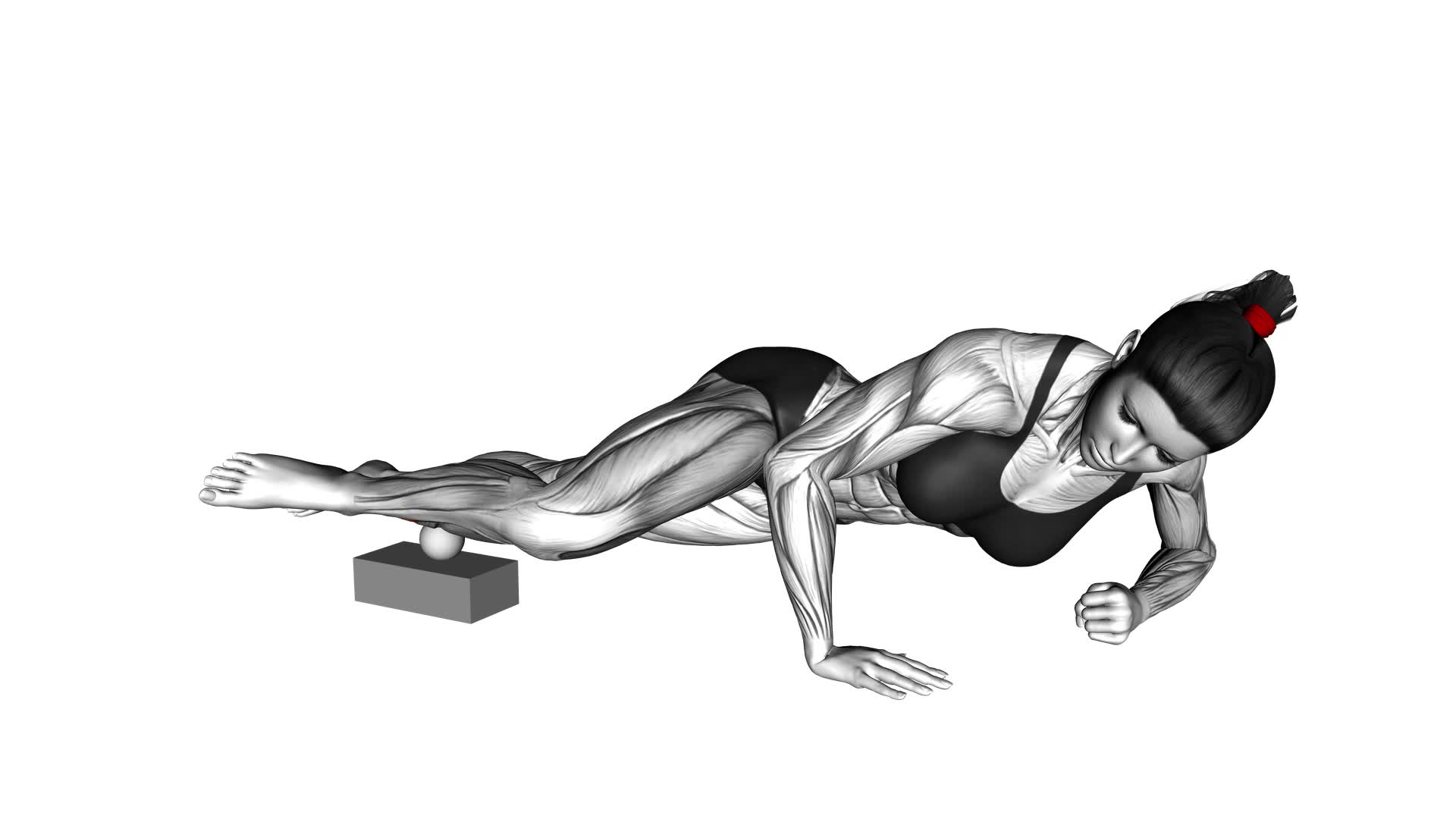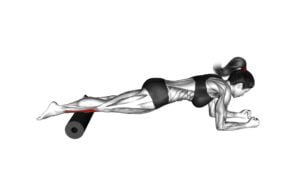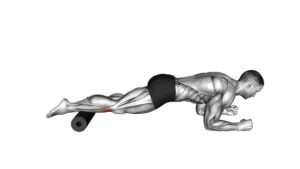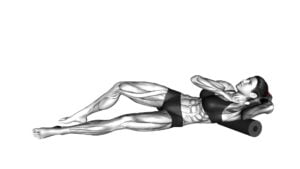Roll Ball Posterior Tibialis (Single Leg) Side Lying on Floor (female) – Video Exercise Guide & Tips

In this video exercise guide, you'll learn how to properly perform the Roll Ball Posterior Tibialis exercise while lying on the floor.
Watch This Exercise Video
This exercise specifically targets the posterior tibialis muscle, providing you with a range of benefits.
You'll also discover the equipment needed for this exercise and receive step-by-step instructions on how to execute it correctly.
By following these tips and avoiding common mistakes, you can maximize your results and prevent injury.
Get ready to improve your lower leg strength and stability!
Key Takeaways
- Improved ankle stability and flexibility
- Strengthening of muscles surrounding the ankle joint
- Reduction of the risk of ankle-related injuries
- Tips for maximizing results and preventing injury
Benefits of the Roll Ball Posterior Tibialis Exercise
You can experience improved ankle stability and flexibility by incorporating the Roll Ball Posterior Tibialis exercise into your workout routine. This exercise is beneficial for injury prevention and muscle activation. By actively engaging the posterior tibialis muscle, you can strengthen the muscles surrounding the ankle joint, which helps to stabilize and support the joint during physical activities.
Injury prevention is a crucial aspect of any fitness regimen. Weak ankles are more prone to sprains and other injuries, which can be debilitating and hinder your progress. The Roll Ball Posterior Tibialis exercise targets the posterior tibialis muscle, which plays a vital role in ankle stability. By strengthening this muscle, you can enhance the overall stability of your ankles, reducing the risk of injuries.
Furthermore, the Roll Ball Posterior Tibialis exercise also promotes muscle activation. The posterior tibialis muscle is responsible for plantar flexion and inversion of the foot, movements that are essential for proper gait and balance. By activating this muscle, you can improve your foot and ankle function, leading to better overall movement and performance.
Incorporating the Roll Ball Posterior Tibialis exercise into your routine can provide significant benefits for ankle stability, injury prevention, and muscle activation. By dedicating time to strengthen this muscle, you can enhance your overall fitness and reduce the risk of ankle-related injuries.
Equipment Needed for the Exercise
To perform the Roll Ball Posterior Tibialis exercise, you'll need a stability ball and a mat. These two pieces of equipment are essential for maintaining proper form and maximizing the effectiveness of the exercise.
Firstly, the stability ball provides an unstable surface that challenges your balance and engages your core muscles. It also allows for a greater range of motion, enabling you to fully stretch and strengthen your posterior tibialis muscles. When selecting a stability ball, choose one that's the appropriate size for your height to ensure proper alignment and stability during the exercise.
Secondly, a mat is necessary to provide cushioning and support for your body as you lie on the floor. This prevents discomfort and helps maintain proper alignment throughout the exercise. Look for a mat that's thick enough to provide adequate padding, but not too thick that it compromises stability.
Step-by-Step Guide to Performing the Exercise
To begin performing the Roll Ball Posterior Tibialis exercise, start by lying on your side on the floor with the stability ball placed near your feet. Follow these steps to improve your balance and strengthen your ankle:
- Position yourself: Lie on your side with your legs straight and the stability ball resting against your feet. Ensure that your body is aligned and your core is engaged.
- Engage your muscles: Contract your posterior tibialis muscle, which runs along the inside of your lower leg. This muscle plays a crucial role in maintaining balance and stability.
- Roll the ball: Use your foot to roll the stability ball towards your body, keeping your ankle flexed. This movement targets the posterior tibialis muscle, helping to strengthen it.
- Repeat and switch sides: Perform the exercise for the desired number of repetitions, then switch to the other side to work the opposite leg.
Common Mistakes to Avoid During the Exercise
When performing the Roll Ball Posterior Tibialis exercise, it's important to be aware of common mistakes to avoid during the exercise. By avoiding these mistakes, you can reduce the risk of injuries and ensure that you're performing the exercise with proper form.
One common mistake isn't maintaining proper alignment of the body. It's important to keep your body in a straight line from head to toe throughout the exercise. Avoid arching or rounding your back, as this can put unnecessary strain on the spine and increase the risk of injury.
Another mistake to avoid is using too much momentum. The goal of this exercise is to engage the posterior tibialis muscle, so it's important to perform the movement slowly and with control. Using momentum can take the emphasis off the targeted muscle and decrease the effectiveness of the exercise.
Additionally, make sure to use the correct size ball for your body. Using a ball that's too large or too small can affect your balance and stability during the exercise, increasing the risk of injury. Choose a ball that allows your body to be properly aligned and supported.
Tips for Maximizing Results and Preventing Injury
To maximize results and prevent injury, it's essential that you consistently maintain proper form and technique during the Roll Ball Posterior Tibialis exercise. Here are some tips to help you get the most out of your workout while minimizing the risk of injury:
- Warm up before starting the exercise: Prior to performing the Roll Ball Posterior Tibialis exercise, it's crucial to warm up your muscles and joints. This can be done through light aerobic exercises or dynamic stretches to increase blood flow and prepare your body for the workout.
- Start with a lighter weight or resistance: If you're new to this exercise or have recently recovered from an injury, it's advisable to start with a lighter weight or resistance. This will allow your muscles to gradually adapt and reduce the risk of overexertion or strain.
- Focus on proper alignment and stability: Pay attention to your body alignment and ensure that you maintain stability throughout the exercise. Keep your core engaged, shoulders relaxed, and spine in a neutral position. This will help you target the right muscles and avoid unnecessary stress on joints.
- Listen to your body and modify as needed: If you experience any pain or discomfort during the exercise, it's important to listen to your body and make necessary modifications. This may involve reducing the range of motion, decreasing the weight or resistance, or seeking guidance from a qualified fitness professional.
Frequently Asked Questions
How Many Repetitions Should I Aim for When Performing the Roll Ball Posterior Tibialis Exercise?
When performing the roll ball posterior tibialis exercise, aim for a recommended number of repetitions to effectively target your muscles. Proper form and technique are crucial for this exercise.
By rolling the ball with your foot while lying on your side, you engage the posterior tibialis muscle. This exercise helps to strengthen and stabilize the lower leg, improving balance and preventing injuries.
Remember to start with a comfortable number of repetitions and gradually increase as you progress.
Is It Necessary to Warm up Before Doing This Exercise?
Before engaging in any exercise, it's crucial to warm up properly. Warming up helps prepare your muscles and joints for the upcoming activity, reducing the risk of injury. It increases blood flow, flexibility, and range of motion.
To warm up effectively, start with some light cardio exercises like jogging or jumping jacks. Then, perform dynamic stretches that target the muscles you'll be using.
Take the time to warm up before attempting the roll ball posterior tibialis exercise to optimize your performance and minimize the chance of injury.
Can I Perform This Exercise if I Have a Previous Ankle Injury?
Yes, you can perform this exercise even if you have a previous ankle injury. It's important to consult with a medical professional or a physical therapist before starting any exercise program, especially if you have a previous injury. They can provide guidance on modifications or alternative exercises that can help with ankle injury rehabilitation.
Remember to listen to your body and stop if you experience any pain or discomfort during the exercise.
Are There Any Modifications or Variations of This Exercise for Beginners?
When starting out with this exercise, there are a few modifications you can make to make it easier for beginners.
- You can use a smaller ball or even a foam roller to decrease the challenge.
- Another modification is to perform the exercise with both legs instead of just one.
As you progress and become more advanced, you can increase the difficulty by using a larger ball or adding resistance bands for added resistance.
How Long Should I Hold the Position During Each Repetition of the Exercise?
To progress in the roll ball posterior tibialis exercise, gradually increase the duration of each repetition. Start by holding the position for a few seconds and gradually work your way up to 10-15 seconds. This will help strengthen the muscles and improve stability.
It's important to avoid common mistakes such as rolling the ball too quickly or using momentum to move the ball. Focus on controlled and precise movements to get the most out of the exercise.
Conclusion
In conclusion, the roll ball posterior tibialis exercise is a beneficial exercise for strengthening the posterior tibialis muscle. It can help improve balance, stability, and prevent injuries related to the ankle and foot.
By following the step-by-step guide and avoiding common mistakes, individuals can maximize their results and prevent any potential injuries. Incorporating this exercise into a regular workout routine can contribute to overall lower body strength and stability.

Author
Years ago, the spark of my life’s passion ignited in my mind the moment I stepped into the local gym for the first time. The inaugural bead of perspiration, the initial endeavor, the very first surge of endorphins, and a sense of pride that washed over me post-workout marked the beginning of my deep-seated interest in strength sports, fitness, and sports nutrition. This very curiosity blossomed rapidly into a profound fascination, propelling me to earn a Master’s degree in Physical Education from the Academy of Physical Education in Krakow, followed by a Sports Manager diploma from the Jagiellonian University. My journey of growth led me to gain more specialized qualifications, such as being a certified personal trainer with a focus on sports dietetics, a lifeguard, and an instructor for wellness and corrective gymnastics. Theoretical knowledge paired seamlessly with practical experience, reinforcing my belief that the transformation of individuals under my guidance was also a reflection of my personal growth. This belief holds true even today. Each day, I strive to push the boundaries and explore new realms. These realms gently elevate me to greater heights. The unique combination of passion for my field and the continuous quest for growth fuels my drive to break new ground.







